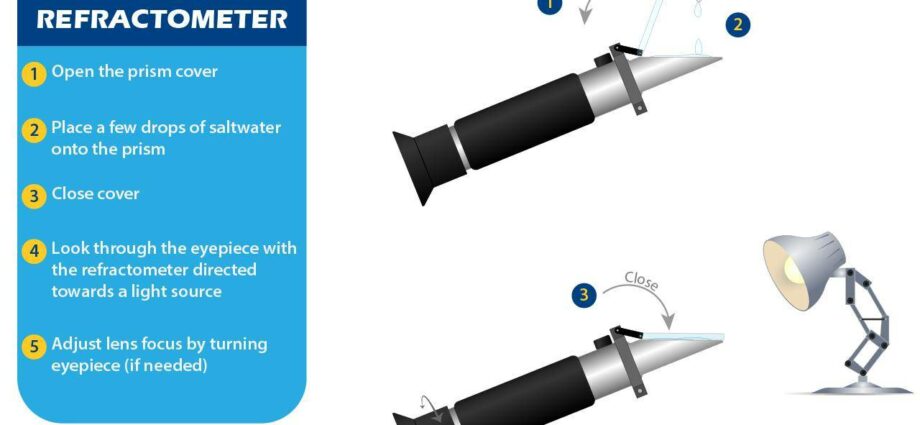Contents
A refractometer is an optical instrument that measures the density of a liquid by refraction of light. Fans of homemade alcoholic drinks use refractometers to determine the concentration of sugar in the wort and to measure the strength of water-alcohol solutions (vodka or well-purified moonshine).
The principle of operation of the refractometer
The operation of a refractometer is based on the difference in the refraction of light in different media. With an increase in the density of the investigated liquid, the index of its refraction (refraction) simultaneously and proportionally increases. For solutions, distilled water is taken as the reference (zero value).
The investigated liquid is applied to the main prism – transparent glass with a high refractive index of sunlight. Through the lens system, the refracted light enters the scale with gradation, dividing it into a light and dark part. The scale can be seen through a monocular. It is the border between the light and dark part of the scale that shows a numerical value, for example, the concentration of sugar in juice or alcohol in water.


Types of refractometers
Refractometers are laboratory, industrial and portable. At home, portable refractometers are used. They are not as functional and accurate as the other two types, but are less bulky and easier to operate.
Home distillers are interested in two types of refractometers:
- for sugar – determine the concentration of sugar in the solution, give the result in units of Brix (Brix, symbol °Bx). For example, 19 °Bx means that 100 g of wort contains 19 g of sucrose and 81 g of water. It is important to note that the ratio is taken by weight, not volume. Most household refractometers operate in the range from 0 to 32-40 Brix, which is enough for the needs of the distiller. By measuring the sugar content in the must before and after fermentation, you can calculate the strength of wine, beer or mash. For similar purposes, another device is used – a saccharometer.
- for alcohol – determine the concentration of alcohol in a water-alcohol solution, most models give the result as a percentage of the volume (% vol.). A similar device is an alcoholometer.
Any refractometer is designed to work in two-component liquids, and the presence of even small concentrations of foreign substances increases the measurement error. For example, acids in fruit juices distort refraction, so the error of a sugar refractometer increases. The situation is the same with an alcohol refractometer – it works well for vodka and refined distillates, but starts to give the wrong value in the case of aged alcohol – cognac or whiskey, and is not suitable for wine and beer at all. This feature must be taken into account when taking measurements.
Also, refractometers are sensitive to the temperature of the liquid and the environment. It is recommended to carry out measurements at a temperature of the investigated liquid and air of 20 °C. The exceptions are refractometers marked ATC (automatic temperature compensation), such devices are capable of operating in the temperature range (+ 10-30 ° C), the exact values, as well as the accuracy class of the device, are indicated in the technical data sheet.
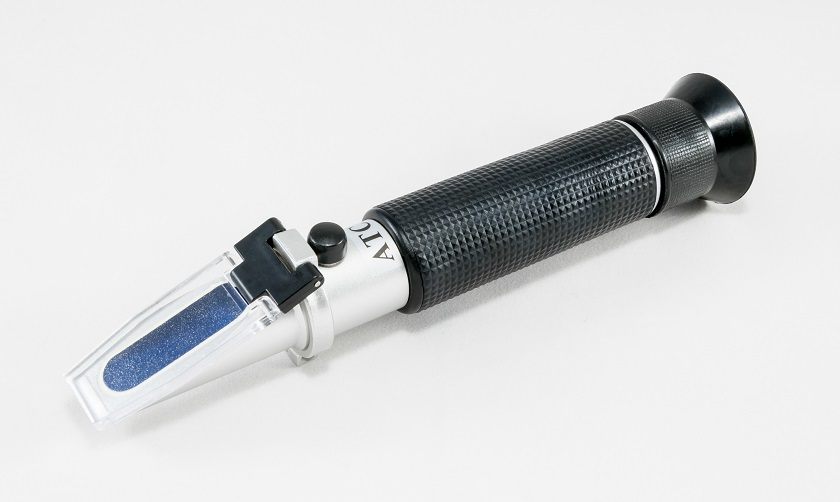

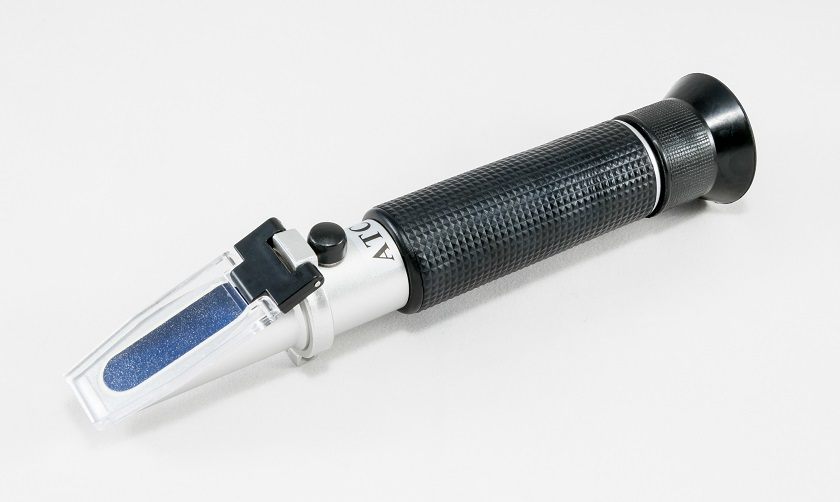

Instructions for the refractometer
Calibration
Before using the refractometer, it must be calibrated. Calibration fluid is included with the device, and if it is not available, then you can take distilled water.
Procedure:
- Raise the protective plate. Drop 2-3 drops of distilled water (calibration liquid) onto the prism.
- Close the protective plate so that the liquid is evenly distributed over the prism, there are no bubbles and dry spots.
- Wait 30 seconds for the sample to adjust to the ambient temperature.
- Point the refractometer with the prism in the direction of natural daylight and look through the monocular. Tighten the calibration screw until the border between the blue and white areas is at zero.
- Open the protective glass, wipe with a soft cloth (included with the refractometer) the glass itself and the prism from the calibration liquid (distilled water). Close device.
In the instructions for most refractometer models, it is recommended to calibrate before each measurement, but in practice this is necessary no more than 1-2 times a month or after the device has not been used for a long time – 3 or more months
How to use a refractometer
- Open the protective glass (plate), drop 2-3 drops of the investigated liquid (juice, beer wort, mash, etc.) onto the prism.
- Close the plate, wait 30 seconds so that the liquid is evenly distributed over the entire prism, there should be no dry spots and bubbles.
- Bring the refractometer to a daylight source (only natural daylight is suitable, even a side fluorescent light source distorts measurements).
- Look through the monocular and take readings. The desired value will be on the border between the dark and light areas.
- Open the refractometer plate. Wipe the protective glass and prism with a soft cloth. Close the device and store.
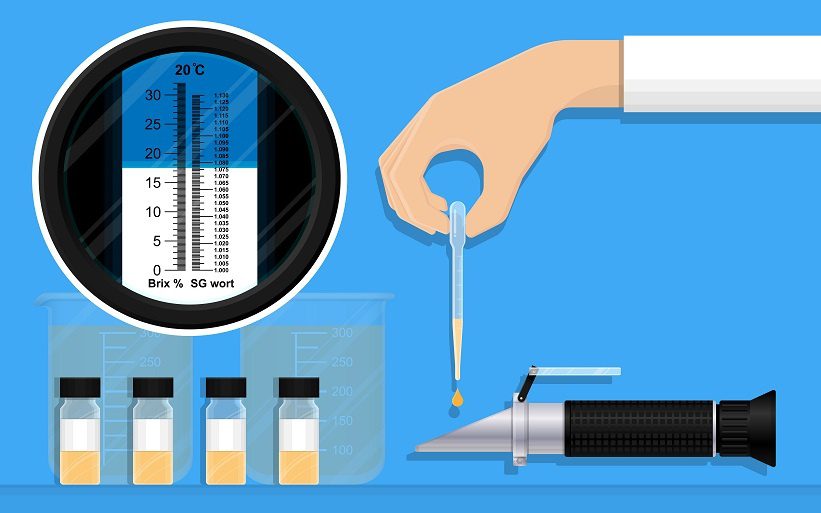

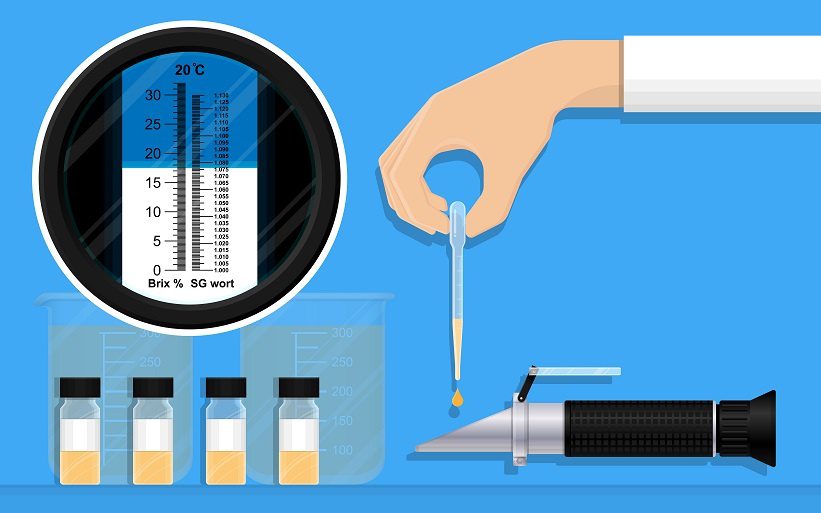

Features of operation
The refractometer should not be immersed in water or other liquids, allowed to get wet, or harsh chemicals should be applied to the prism, which could damage its coating. The instrument can only be cleaned with the cloth supplied.
How to measure the strength of wine, mash or beer with a refractometer
For these purposes, it will not work to use an alcohol refractometer, because sugar and other substances will significantly distort the measurements.
You can find out the strength of wine (braga, beer) using a sugar refractometer. To do this, you need to measure the sugar content of the wort before and after fermentation, then make calculations.
It is known that 1% of fermented sugar yields about 0,6% alcohol. For example, if before fermentation the juice contained 22% sugar, and after – 3%, then the approximate strength of the wine will be 11,4% ((22 – 3) * 0,6 = 11,4).
A more advanced and accurate calculation method is included in the alcohol calculator before and after fermentation, you need to enter the values not in Brix, but in Wort SG units (not available on all devices).
Counting in progress…
Enter the initial data on the left
The output will be a wort with a content










